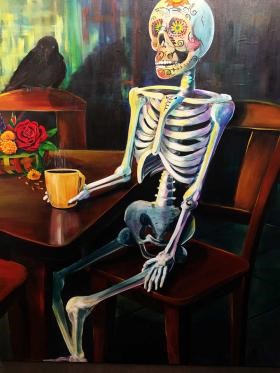The ICC is once again the first stop for Lubbock’s annual Day of the Dead procession
Annual Day of the Dead procession returns Friday to Lubbock
Day of the Dead began as month-long Aztec holiday
Although celebrated in countries worldwide, the two-day holiday known as Day of the Dead, or Dia de los Muertos, originated in Mexico, where it remains a national holiday. This special holiday continues to find people worshiping, above all, remembrance.
It will be celebrated with an annual gallery procession on Friday in Lubbock: 5:30 p.m., International Cultural Center; 6:30 p.m., Texas Tech School of Art; 7:30 p.m., LHUCA; and 8:30 p.m., Buddy Holly Center.
Nevertheless, the holiday traditionally is observed on Nov. 1 and 2, coinciding with the Catholic holidays of All Saints Day and All Souls Day.
The celebration is further divided, with Nov. 1 honoring deceased youth and Nov. 2 honoring adult friends and family members who have been lost. Nov. 1 also is called Dia de los Inocentes (Day of the Innocents) or Dia de los Angelitos (Day of the Little Angels). Nov. 2 simply is Dia de los Muertos (Day of the Dead).
Family members who celebrate Day of the Dead often build altars for the deceased in their homes, schools or public places . Many will honor the dead with gifts of sugar skulls, chocolate, marigolds (the Mexican flower of death), sweetbreads and trinkets.

"Skeleton Coffee," an acrylic work by Lubbock visual artist June Musick
Provided by Pat Maines
Vigils also are held at grave sites, where family members or friends deliver ofrendas, or offerings. Candles and photos often are used.
The practice of honoring loved ones who have died began more than 4,000 years ago when the Aztecs held a monthlong celebration to welcome the spirits of loved ones who return to visit, according to art-is-fun.com/dia-de-los-muertos-history. The Aztecs believed that the dead preferred to be celebrated, not mourned.
The holiday lasted from the end of July to mid-August; this ninth month on the Aztec calendar arrived during the corn harvests.
When Spanish Conquistadores arrived with their Catholic faith in what is now Mexico, one goal was to convert indigenous peoples to Catholicism and do away with their “pagan” rituals.
Day of the Dead survived and, in fact, was altered to coincide with the Catholic holy days. Yet native folk customs and traditions prevailed.
The Aztec goddess Mictecacihuatl found a new identity as the modern Catrina: a lanky, female skeleton wearing lavish, expensive clothing and giant, ornate hats.
Even the banks in Mexico close on Day of the Dead, which also is celebrated in Ecuador, Guatemala and other areas in Central and South America — and in cities in Texas and California with rising Hispanic populations.
The gallery procession in Lubbock began in 1999. The same four galleries take part today, at each location below.
- 5:30 to 7 p.m. - International Cultural Center, 601 Indiana Ave., 742-3667
- 6:30 to 7:30 p.m. - Texas Tech School of Art, 18th Street and Flint Avenue, 742-1947
- 7:30 to 8:30 p.m. - LHUCA (Louise Hopkins Underwood Center for the Arts), Icehouse, 511 Ave. J, 762-8606
- 8:30 to 9:30 p.m. - Buddy Holly Center, 1801 Crickets Ave., 775-3560
International Affairs
-
Address
601 Indiana Avenue, Lubbock, TX 79409-5004 -
Phone
806.742.3667 -
Email
oia.reception@ttu.edu
